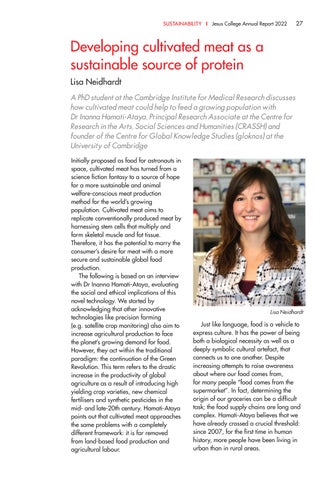SUSTAINABILITY I Jesus College Annual Report 2022
27
Developing cultivated meat as a sustainable source of protein Lisa Neidhardt A PhD student at the Cambridge Institute for Medical Research discusses how cultivated meat could help to feed a growing population with Dr Inanna Hamati-Ataya, Principal Research Associate at the Centre for Research in the Arts, Social Sciences and Humanities (CRASSH) and founder of the Centre for Global Knowledge Studies (gloknos) at the University of Cambridge Initially proposed as food for astronauts in space, cultivated meat has turned from a science fiction fantasy to a source of hope for a more sustainable and animal welfare-conscious meat production method for the world’s growing population. Cultivated meat aims to replicate conventionally produced meat by harnessing stem cells that multiply and form skeletal muscle and fat tissue. Therefore, it has the potential to marry the consumer’s desire for meat with a more secure and sustainable global food production. The following is based on an interview with Dr Inanna Hamati-Ataya, evaluating the social and ethical implications of this novel technology. We started by acknowledging that other innovative technologies like precision farming (e.g. satellite crop monitoring) also aim to increase agricultural production to face the planet’s growing demand for food. However, they act within the traditional paradigm: the continuation of the Green Revolution. This term refers to the drastic increase in the productivity of global agriculture as a result of introducing high yielding crop varieties, new chemical fertilisers and synthetic pesticides in the mid- and late-20th century. Hamati-Ataya points out that cultivated meat approaches the same problems with a completely different framework: it is far removed from land-based food production and agricultural labour.
Lisa Neidhardt
Just like language, food is a vehicle to express culture. It has the power of being both a biological necessity as well as a deeply symbolic cultural artefact, that connects us to one another. Despite increasing attempts to raise awareness about where our food comes from, for many people “food comes from the supermarket”. In fact, determining the origin of our groceries can be a difficult task; the food supply chains are long and complex. Hamati-Ataya believes that we have already crossed a crucial threshold: since 2007, for the first time in human history, more people have been living in urban than in rural areas.































